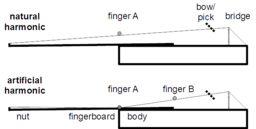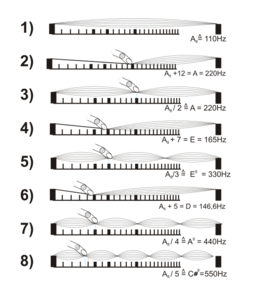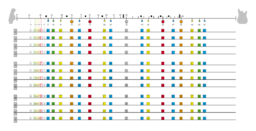Engineering:Artificial harmonic
To produce an artificial harmonic, a stringed instrument player holds down a note on the fingerboard or neck with one finger of their fretting hand (thereby shortening the vibrational length of the string) and uses another finger to lightly touch a point on the string that is an integer divisor of its vibrational length, and plucks or bows the side of the string that is closer to the bridge. This technique is used to produce harmonic tones that are otherwise inaccessible on the instrument. To guitar players, varieties of this technique are known as a pinch harmonic, tapped harmonic, and harp harmonic. "This gives both the electric and the acoustic guitar quite a bit of versatility and sonic flare [sic]."[1]
Artificial harmonics are produced by shifting the natural sectional parts of a string by means of the first finger, which, while being set, forms an artificial saddle, thereby shortening the string, and the fourth finger lightly touching the sectional parts of the shortened string.[2]
This technique, like natural harmonics, works by canceling out the fundamental tone and one or more partial tones by deadening their modes of vibration. See node. It is traditionally notated using three simultaneous noteheads in one stave: a normal notehead for the position of the firmly held finger, a square notehead for the position of the lightly pressed finger, and a small notehead for the resulting pitch.[2] "The usual notation for an artificial harmonic is a solid note for the thumb placement with a diamond shape note...above it," indicating the node.[3]
These tones have the same acoustic characteristics as the natural harmonic tones. Additionally, it is possible (though not always necessary) to play them with vibrato. In the orchestra, they are used more rarely than the natural harmonic tones as they are more difficult to play. The advantage of the artificial harmonic tones is that they are not restricted to the overtone series of the open strings.[4]
The most commonly used artificial harmonic, due to its relatively easy and natural fingering,[2] is that in which, "the fourth finger lightly touches the nodal point a perfect fourth above the first finger. (Resulting harmonic sound: two octaves above the first finger or new fundamental.),"[5] followed by the artificial harmonic produced when,[2] "the fourth finger lightly touches the nodal point a perfect fifth above the first finger (Resulting harmonic sound: a twelfth [compound perfect fifth] above the first finger or new fundamental.),"[5] and, "the third finger lightly touches the nodal point a major third above the first finger. (Resulting harmonic sound: two octaves and a major third above the first finger or new fundamental.)"[5][6]
Detailed explanation
Overtones
Artificial harmonics are produced by stopping the string with the first or second finger, and thus making an artificial 'nut,' and then slightly pressing the node with the fourth finger. By this means harmonics in perfect intonation can be produced in all scales.—Grove's Dictionary of Music and Musicians (1879)[7]
When a string is plucked or bowed, the string vibrates at several frequencies. The vibration along the entire length of the string is known as the fundamental, while vibrations occurring between points along the string (known as nodes) are referred to as overtones. The fundamental and overtones, when sounded together, are perceived by the listener as a single tone, though the relative prominence of the frequencies varies among instruments, and contribute to its timbre.
Harmonics
This technique of the fourth finger is peculiar to [artificial] harmonic-playing. Here its function is, not to stop [fully press down] the string, but to touch [lightly] the nodal point.[5]
Harmonics are produced on the instrument by lightly touching a string (as opposed to fretting it) at any of several points along its length. The fundamental tone will not vibrate; specific overtones, however, will, resulting in a chimelike tone. Harmonics produced by this method based on open-string fundamentals are termed "natural." If the string is fretted, the harmonics are termed "artificial." Natural harmonics may only be sounded at the strings' nodes. The nodes for natural harmonics fall at the following points along the guitar's neck:
Fret Note 1⁄2 12 octave tonic 1⁄3 7, 19 octave + fifth 1⁄4 5, 24 2nd octave 1⁄5 4 (3.9), 9, 16 2nd octave + third 1⁄6 3.2 2nd octave + fifth 1⁄7 2.7 2nd octave + minor seventh 1⁄8 2.3 3rd octave 1⁄9 2 3rd octave + second 1⁄10 1.8 3rd octave + third
References
- ↑ Hurwitz, Tobias (2006). The Total Rock Guitarist, p.85. Alfred Music. ISBN:9780739038505.
- ↑ 2.0 2.1 2.2 2.3 Scholz, Richard (1900). The Technique of the Violin, p.9. Translated by Saenger, Gustav; ed. New York: Carl Fischer. [ISBN unspecified].
- ↑ Potter, Louis (1995). The Art of Cello Playing, p.194. Alfred Music. ISBN:9781457400353.
- ↑ Sevsay, Ertuğrul (2013). The Cambridge Guide to Orchestration, unpaginated. Cambridge. ISBN:9781107067486.
- ↑ 5.0 5.1 5.2 5.3 Grimson, Samuel B. and Forsyth, Cecil (1920). Modern Violin-Playing, p.79-80. New York: H. W. Gray (Novello). [ISBN unspecified].
- ↑ Hurwitz (2006), p.87.
- ↑ Grove, George (1879). A Dictionary of Music and Musicians (A.D. 1450-1889), Vol. 2, p.665. Macmillan. [ISBN unspecified].





